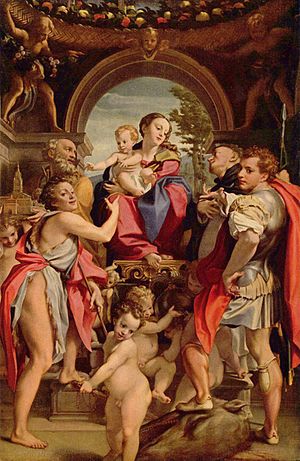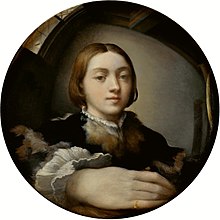The Madonna of St. George (Correggio)

|
| The Madonna of St. George |
|---|
| Antonio da Correggio , around 1530/32 |
| Poplar wood |
| 285 × 190 cm |
| Old Masters Picture Gallery |
The last altarpiece, The Madonna of St. George , created by the Italian painter Correggio belongs to the inventory of the Old Masters Picture Gallery in Dresden .
Image description
“ The Madonna of Heil. George. In the stately hall, whose round dome base, richly decorated with fruit wreaths, is supported by two stone-colored angels standing in the spandrels on the cornice, Mary, seen from below, is enthroned on high pedestals in front of the round arch, through which one looks out into the open. The naked Christ Child on her lap stretches out his two arms to the left, where he is safe. Bishop Geminianus removes his model of the church from the angel, while further ahead John the Baptist in a piquant youthful figure places his left foot on the step of the throne and points up to the Savior with his right hand. On the right stands the martyr Peter in his monk's robe and speaks animatedly with his hands, but further ahead, putting his left foot on the head of the slain kite, putting his left arm in his side, half-seen from behind, the young knight Georg to him Four naked children play with his helmet and his weapons. "
perspective

The picture can be used as an example of the transition in painting from the High Renaissance to Mannerism , the sophistication of which is shown here primarily in perspective. Correggio presents a Sacra Conversazione , which, as if taken with a wide-angle lens , overcomes traditional perspectives and thus comes to an exaggeration of the Madonna sitting on the throne with the child. This form of representation as in a convex mirror was a popular motif of this painting era, the ideal of which was to overcome the natural model in favor of increased expression.
Mary with the child
In the middle of the picture the Madonna is seated on a throne with her child on her lap. The boy stretches his arms out to the left to the model of the city of Modena, as he would probably like to have it to play with.
The feet of the Madonna are on a pedestal, which is arranged exactly in the optical axis of the picture. She is dressed, as in many other Madonna pictures, with a blue hooded cloak over a red shirt and with a golden fabric veil.
The Holy
The following figures line the throne of Maria (from left to right)
John the Baptist

In contrast to the traditional depictions, John the Baptist is shown here in a lovely youthfulness, which, if he could not be recognized by his attributes (cross staff, pointing gesture of the hand, camel hair coat, unkempt bare feet), could also be interpreted as a female figure. This crossing of boundaries as a characteristic of Mannerism builds on the depictions of the Baptist as a youthful ascetic, which were not uncommon, especially in Italy, since the early Renaissance.
Geminianus of Modena
The Holy. Geminianus holds the model of the city of Modena, supported by a cherub, in his hands. He is dressed in his chasuble , the crook of his crook could be seen behind the Baptist's head.
Peter Martyr
Petrus Martyr , the namesake of the commissioning brotherhood, stands to the right of the throne and looks up at Mary with his head tilted to one side, while his left hand points out of the picture. He is dressed with a black cowl over a white tunic . His unnatural head posture can be explained by his most common attribute, a knife or sword in a gaping head wound, whereby only the point of this weapon can be seen above his forehead. With the help of this trick it was possible for Correggio to avoid a direct representation of this visibly brutal attribute in favor of the cheerful and bright scenery. Another attribute, the dagger stuck in the chest, is also difficult to recognize.
George
The St. George , in the armor of a Roman officer, looks with victory pose at the audience, his left leg, he relied on the severed head of the dragon. His legs are made of leather, and his shoes have spurs .
The putti
The putti in the foreground are based on literature based on an ancient motif that the painter Aëtion created on the occasion of the marriage of Alexander the Great to Roxane . Lukian had described the picture and the depicted Cupids two hundred years later as follows:
". . . On the other side of the picture, Cupids are playing with Alexander's weapons; two of them carry his lance, and act like carpenters when they have a heavy beam on their shoulders: another couple draws a third who introduces the king himself, as if on a chariot, on his shield, whom they approach Hold the handle. Another has crawled into the back of the armor, where he seems to be lurking in order to frighten the latter couple if they come near them.
. . . Incidentally, this accessory is nothing less than a mere idle play by the artist: Aëtion wanted to indicate Alexander's love for warlike deeds, which he would not forget about the beautiful Roxane of weapons. - "
The painter Sodoma , a contemporary of Correggio, tried to depict this scene in a fresco in the Villa Farnesina in Rome.
Provenance

The painting was commissioned by the Brotherhood of San Pietro Martire in Modena in 1530/1532. Although the brotherhood was very concerned about the picture, they could not resist the urging of Duke Francesco I d'Este , who requested the picture for his picture gallery in 1649. As compensation he offered a copy of Guercino complete with frame and a princely present. From the ducal gallery in Modena it was brought to Dresden in 1746 together with 100 other paintings.
literature
- Wilhelm Schäfer: Catalog of the royal painting gallery in Dresden. Kaufmann's Buchhandlung, Dresden 1876, p. 20
- Harald Marx (ed.): Old Masters Picture Gallery. Volume I: The exhibited works. Verlag der Buchhandlung Walther König, Cologne 2005, pp. 90/91.







